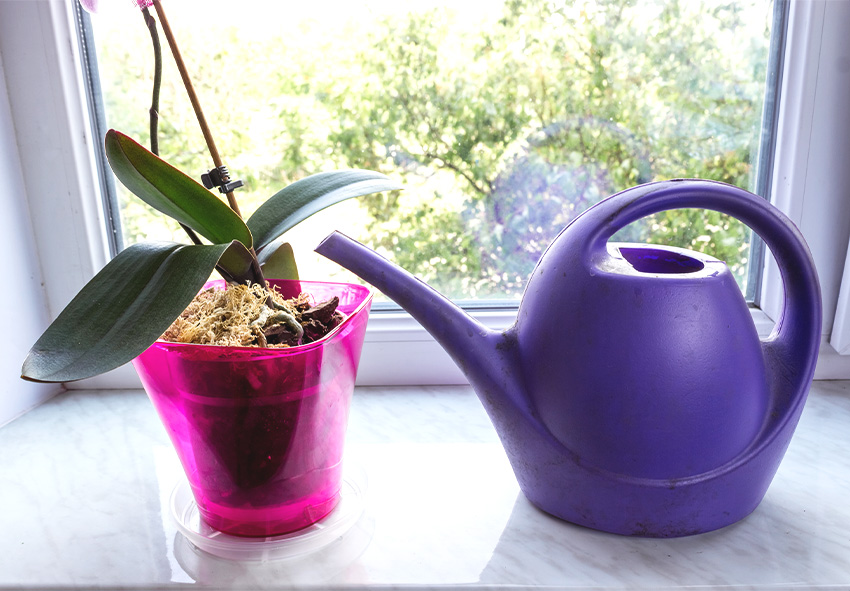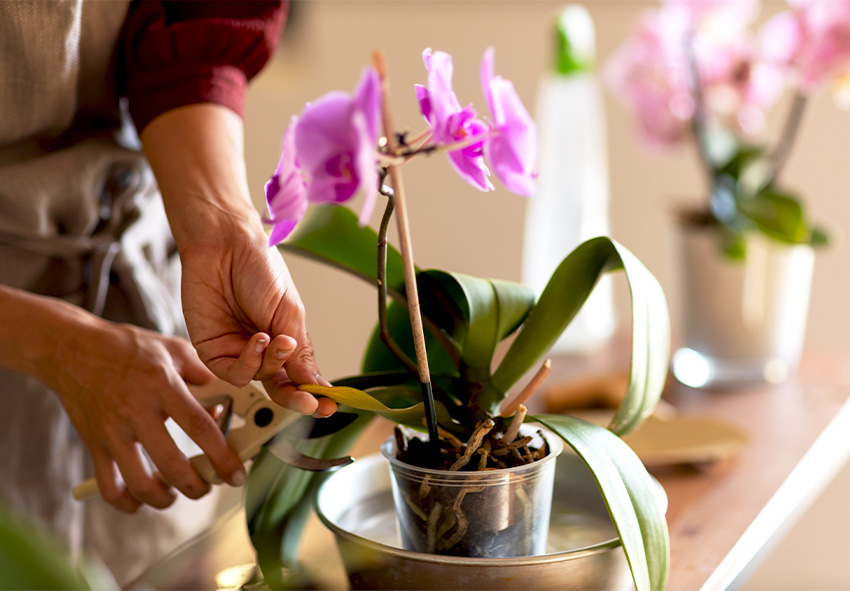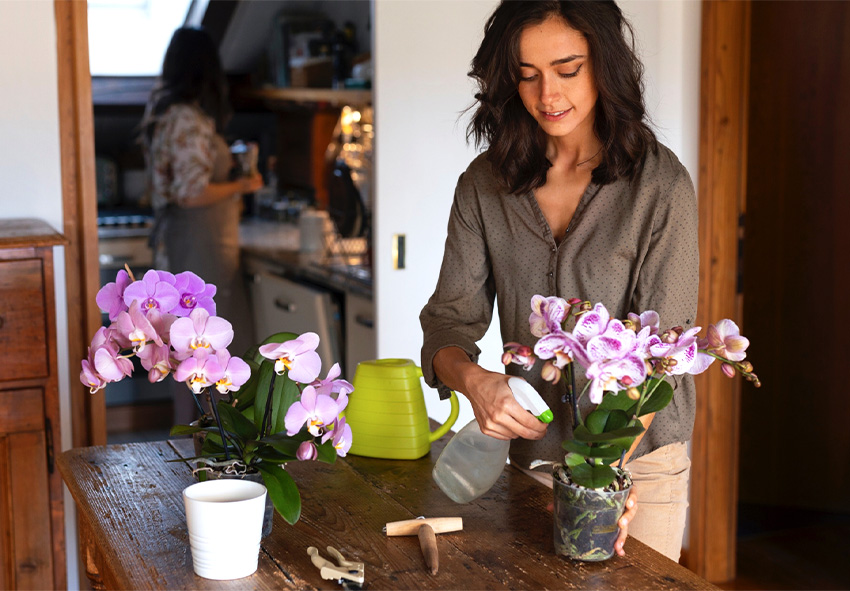Orchids are among the most beloved houseplants, admired for their exotic flowers and graceful form. While they may seem delicate, orchids can thrive year after year with the right seasonal care. Adjusting your orchid care routine according to spring, summer, autumn, and winter ensures strong growth, healthy leaves, and stunning blooms. Our gardening blog is a perfect place to find all the information about daffodils and other plants you need!
Understanding Seasonal Needs of Orchids

Orchids follow a natural growth cycle that changes with the seasons. From periods of active growth in spring and summer to dormancy in fall and winter, each stage requires specific care. By tailoring your watering, light, and feeding habits, you can help orchids adapt to these shifts and encourage long-lasting health.
Spring Orchid Care
As days grow longer and temperatures warm, orchids begin their active growth phase. Spring is the ideal time to encourage leaf and root development, preparing the plant for abundant blooms. This season calls for increased watering, more sunlight, and balanced fertilization.
Light and Temperature Adjustments
During spring, orchids benefit from bright, indirect sunlight. Placing them near an east-facing window helps them soak up gentle morning light without burning the leaves. Keep daytime temperatures between 18–24°C (65–75°F) for optimal growth.
Watering and Humidity in Spring
As orchids wake from winter dormancy, they require more frequent watering. Aim to water once the potting medium feels dry, while maintaining humidity around 50–70%. Using a humidity tray or misting can prevent leaves from drying out.
Fertilizing for Growth
During the active growing season, orchids require regular feeding to support healthy leaf development and strong root systems. Fertilizing correctly ensures your orchids store enough energy for future blooms. Using the right type and frequency of fertilizer can make the difference between average plants and thriving, flower-ready orchids. Here are some tips for you:
- Use a Balanced Fertilizer: Apply a balanced orchid fertilizer such as 20-20-20 to provide essential nutrients for leaves, roots, and overall growth.
- Dilute for Safety: Always dilute fertilizer to half or a quarter of the recommended strength, as orchids are sensitive to over-fertilization.
- Feed Weekly, Weakly: Follow the common orchid rule — light feeding every week instead of heavy feeding occasionally, which prevents nutrient buildup.
- Flush the Potting Medium: Once a month, water thoroughly without fertilizer to wash away any accumulated salts that can damage roots.
- Switch in Late Summer: Toward the end of summer, transition to a fertilizer with lower nitrogen and higher phosphorus to prepare for blooming.
Summer Orchid Care
Summer is the peak growing season for orchids, but high temperatures and intense light can stress the plants. Providing proper shade, increased hydration, and steady feeding helps orchids stay healthy during hot months.
Managing Heat and Sunlight Exposure
Strong summer sun can scorch orchid leaves, so use sheer curtains or move plants slightly away from direct windows. Good air circulation is also key to keeping orchids cool and preventing fungal issues.
Fertilizer and Feeding Tips
Continue feeding orchids with a high-nitrogen fertilizer in summer to promote lush leaves and roots. Fertilize weekly with a diluted solution, following the “weakly, weekly” rule. Healthy summer growth leads to stronger flowering later in the year. For more useful tips check out our full guide for orchids.
Watering Schedule in Hot Weather
Orchids need more water in summer due to evaporation. Water early in the morning to allow excess moisture to evaporate during the day. Ensure pots have proper drainage to avoid root rot.
Autumn Orchid Care

As days shorten, orchids naturally slow their growth. This season is a transition period where watering and feeding need to be gradually reduced. Autumn care focuses on preparing orchids for their resting phase.
Reducing Watering as Growth Slows
Orchids require less water in autumn compared to summer. Allow the potting mix to dry slightly more between waterings, but never let it become completely dry. Adjusting early helps prevent overwatering in winter.
Light and Temperature Adjustments in Fall
As autumn arrives, orchids begin transitioning from their active growth stage to a slower rhythm. Proper adjustments to light and temperature during this season are essential for supporting healthy blooms in the upcoming months. By creating the right conditions, you can mimic the orchid’s natural habitat and encourage flower spike development:
- Maximize Natural Light: Place orchids near a bright east or south-facing window to make the most of reduced daylight. Clean the window glass to allow maximum light penetration.
- Supplement with Grow Lights: If natural light is limited, especially in northern climates, consider using LED grow lights for 10–12 hours daily.
- Lower Night Temperatures: Reduce nighttime temperatures to around 55–60°F (13–15°C). This drop helps trigger flowering in many orchid varieties.
- Avoid Temperature Fluctuations: Keep orchids away from drafty windows, heaters, or vents that cause sudden temperature changes.
- Maintain Daytime Warmth: Aim for daytime temperatures between 65–70°F (18–21°C) to balance the cooler nights and encourage steady growth.
Preparing for Dormancy
Some orchid varieties, such as Cymbidiums, enter a dormancy stage in late autumn. Reduce feeding and place them in a cooler spot to mimic their natural cycle. This resting period encourages more blooms in the next season.
Winter Orchid Care
Winter is typically the resting phase for orchids, though some varieties may bloom during this season. With lower light levels and cooler temperatures, orchids require less water and fertilizer but still need steady attention to remain healthy.
Managing Dormancy Period
During winter dormancy, orchids slow their metabolic processes. This is not a sign of decline but a natural part of their cycle. Minimize disturbances and provide stable conditions to support rest.
Light and Temperature Needs in Winter
Winter light can be scarce, so place orchids near a south-facing window or supplement with grow lights. Keep daytime temperatures around 18–21°C (65–70°F) while avoiding drafts from windows and doors.
Watering and Fertilizer Reduction
Orchids need far less water in winter. Water sparingly, about once every 10–14 days, depending on your indoor environment. Fertilizer should be reduced or paused until spring growth resumes.
Common Seasonal Challenges and Solutions

Even with attentive care, orchids may face challenges throughout the year. Being proactive and adjusting your routine helps prevent long-term damage. Seasonal problems often relate to pests, diseases, and environmental stress.
- Dealing with Seasonal Pests and Diseases: Spider mites and aphids can appear in warmer months, while fungal issues thrive in damp conditions. Regularly inspect leaves and roots, and use neem oil or insecticidal soap if pests are spotted.
- Preventing Root Rot in Humid Months: High summer humidity combined with overwatering can cause root rot. Always use a well-draining orchid potting mix and ensure pots have proper airflow. Healthy roots are the foundation of thriving orchids.
- Handling Dry Air in Winter: Indoor heating in winter often creates dry air that stresses orchids. Place a humidity tray beneath the pot or use a humidifier to maintain comfortable levels around 40–60%. Grouping orchids together also helps retain moisture.
Conclusion
Caring for orchids year-round is a rewarding process that brings beautiful blooms and lush foliage. By tailoring care to each season, you support the plant’s natural growth cycle and prevent common issues. With consistency and patience, your orchids will thrive and fill your home with elegance year after year!
Frequently Asked Questions (FAQs) about Seasonal Care for Orchids
1. How often should I water orchids during different seasons?
Orchids need more frequent watering in spring and summer when actively growing, usually once or twice a week. In fall and winter, reduce watering as growth slows down, keeping the medium slightly moist but never soggy. Always check the potting mix before watering to avoid root rot.
2. What type of fertilizer is best for orchids year-round?
A balanced orchid fertilizer, such as 20-20-20, works well during the active growing season. Use it in diluted form weekly. In late summer and fall, switch to a low-nitrogen, high-phosphorus formula to encourage blooming. Flushing the potting mix monthly prevents salt buildup and keeps roots healthy.
3. How should I adjust light and temperature for orchids in each season?
In spring and summer, orchids thrive with bright but indirect light and warm temperatures. In fall, gradually reduce light exposure to match shorter days, while in winter, ensure they still get enough light indoors. Maintain steady temperatures, avoiding cold drafts or excessive heat near windows and heaters.
4. Do orchids need special care during winter dormancy?
Yes, most orchids slow down their growth in winter. During this period, reduce watering and fertilization while keeping humidity levels steady. Place them in a bright spot away from direct cold drafts. This rest period helps orchids store energy for strong blooms in the following season.
5. Can I order orchids from your online store?
Yes, you can! Our online store Dutch-bulbs.com offers a wide selection of orchid plants, including different varieties and colors. We take pride in providing top-quality plants that are carefully cultivated and shipped with care to ensure they reach you in perfect condition.
Published: 02.09.2025
